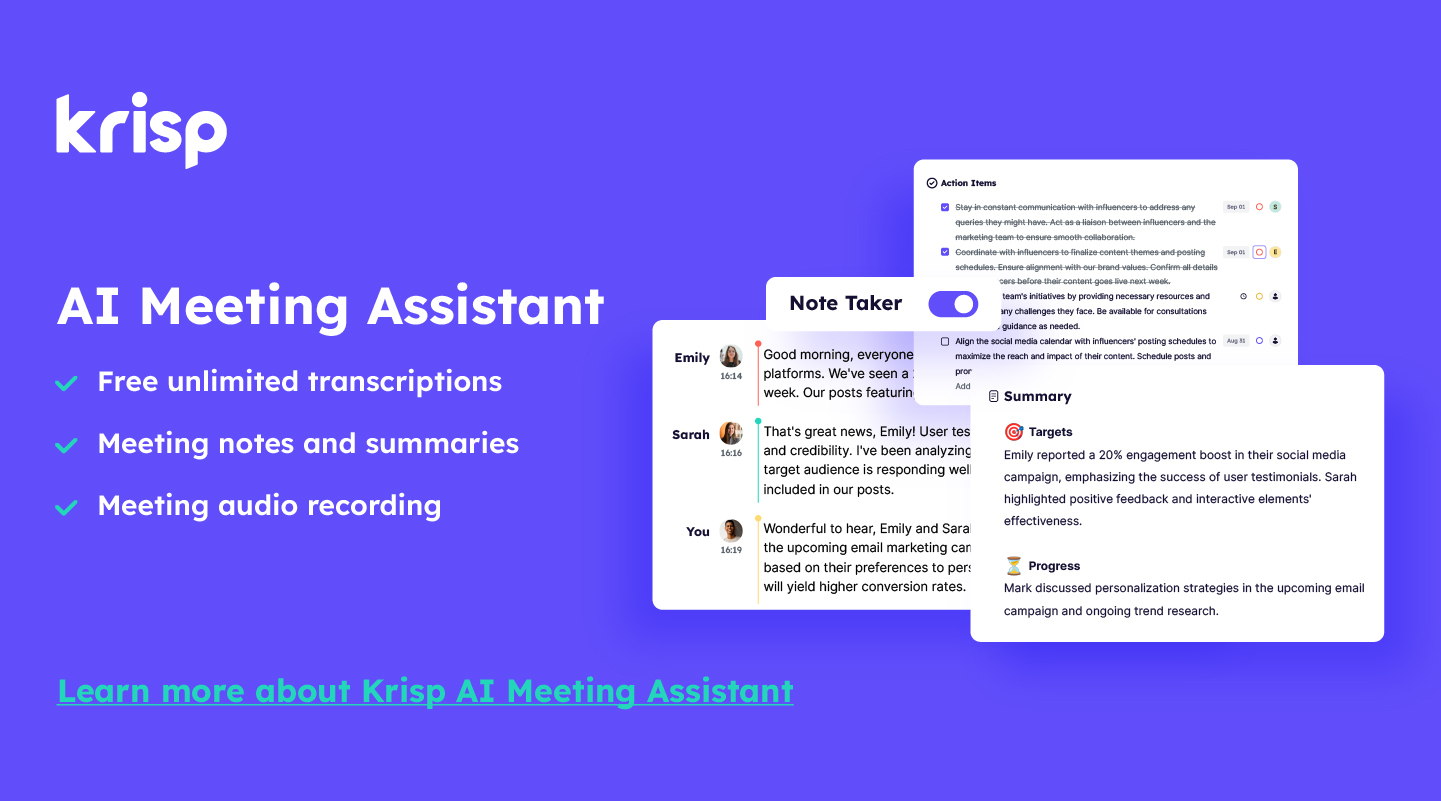The competition in any field is so intense that the need for new, fresh ideas is growing daily. Rapid ideation is all about generating as many ideas as you can without editing them. It’s a technique widely used in brainstorming. The method encourages team members to generate as many ideas as possible, even if they seem funny or silly, to create ideas that can serve as raw material to work on. Rapid ideation can be practiced in person and in a virtual environment. Tools like Krisp help facilitate rapid ideation by blocking out any noise (like typing or small rustling sounds) that might disrupt virtual brainstorming. When you feel comfortable in a virtual environment and can hear clearly, you’re brain is freed up to generate ideas.
What Is a Rapid Ideation?
Rapid ideation involves generating as many ideas as possible in a short period. This practice is commonly used in brainstorming sessions, sprints, and other meetings where idea generation is essential. As you can see the definition of rapid ideation is simple. The goal is to produce many ideas without worrying about editing or overthinking whether they are practical. Ideas can be funny or silly—you don’t need to focus on making them perfect or rational. Every seemingly silly idea can have value in the proper context.
After the rapid ideation session, every idea, even the unconventional ones, can be reviewed, refined, and combined to create innovative and impactful solutions. Generating more ideas increases the chances of finding the best approach.
The Benefits of Rapid Ideation
Every rapid ideation brainstorming session or rapid ideation sprint can mark the beginning of drastic changes. Here are some benefits worth mentioning:
Efficient problem-solving: As we all know, we can’t count on waiting around for a brilliant idea to solve our problems. You can quickly find a solution and speed up the process by generating rapid ideas.
Boost creativity: Focus on quantity rather than quality. Participants shouldn’t overthink it. They should feel comfortable sharing any ideas they have.
Collaboration: Being comfortable and sharing ideas in a group can help team members feel closer. Strong collaboration is important; it’s the foundation of new, fresh ideas, where everyone feels comfortable sharing even their wildest ideas.
Reduced risk of bias: In some brainstorming sessions, certain voices may dominate, which is a bad practice and can limit the chances of discovering creative ideas. Rapid ideation ensures that every team member participates, which is key to creating something new and innovative.
Rapid Ideation Brainstorming Techniques
While rapid ideation is a natural process that doesn’t have strict rules, you can still use certain techniques to make the process more enjoyable. Here are several rapid ideation brainstorming techniques that can help you become a rapid ideation wizard in a short time:
- Mind mapping: Start with a central idea and let it branch out like a tree with connected ideas. This is a great practice as it helps uncover related ideas and solutions that might go unnoticed with other methods and can help visualize ideas. Our minds can sometimes turn chaotic with many thoughts, but by visualizing them, we can better organize and process the ideas afterward.
- SCAMPER: The word “SCAMPER” is an acronym that stands for Substitute, Combine, Adapt, Modify, Put to another use, Eliminate, and Reverse. This technique is all about improving an existing idea by asking questions like: What can be substituted? Can something be combined? Can it be adapted or modified?
- Crazy eights: In eight minutes, participants are asked to sketch eight different ideas. The time pressure encourages out-of-the-box thinking and rapid decision-making.
- Brainwriting: This technique is ideal for larger teams where verbal brainstorming might lead to noise and overshadow shy participants. Instead of speaking out, team members write down their ideas on paper. After a few minutes, they pass their ideas to the next person, who builds upon them. This method lets every team member contribute equally, encourages collaboration, and helps develop more well-rounded ideas.
How to Run a Successful Rapid Ideation Session
If you don’t know how to start or organize your rapid ideation sessions, we can help. Over time, you’ll understand which techniques work best for your team.
- Define the objective: Everyone should know the goal of the session. When team members are clear about the main objective, it becomes easier to work toward achieving it.
- Set a time limit: Setting a time limit is essential, as rapid ideation works best with a time constraint. Whether it’s 5 minutes or 1 hour, keep the session short to maintain focus and energy.
- Create a safe space: Foster a warm, trusting environment where every team member feels at ease. Encourage participants to share all ideas, even the wild ones. This is a judgment-free zone, where no idea is too “out there.”
- Use the right tools: Depending on your team’s preference, you can use physical tools like whiteboards and sticky notes, or digital platforms like Miro or Trello to organize ideas. For virtual brainstorming, use tools like Krisp to keep your environment quiet.
- Review and refine: Once the ideation sprint is complete, gather the best ideas and evaluate their feasibility. You can then move on to prototyping, testing, or further refinement.
Rapid Ideation Examples From Popular Companies
Companies use rapid ideation to come up with and refine ideas. Instead of spending weeks on research, teams hold brainstorming sessions to generate as many ideas as possible and then narrow them down to the best ones.
Many well-known companies use this approach to stay competitive and innovate. Here are some examples
1. Google: 20% Time

Google has long been famous for its “20% time” policy, where employees are encouraged to spend 20% of their time on projects that are not directly related to their primary job. This policy promotes rapid ideation, allowing employees to generate and develop new ideas quickly. Some of Google’s most successful products, like Gmail and Google News, were born out of this idea-generating freedom. By giving employees the time and space to ideate rapidly, Google fosters a culture of constant innovation.
2. Apple: Think Different

Apple is also known for its rapid ideation approach, particularly in developing iconic products like the iPhone and iPad. Guided by its famous slogan, “Think Different,” the company fosters a culture of brainstorming and collaboration, where employees are encouraged to think creatively and develop innovative solutions. During the product development stages, Apple teams engage in rapid ideation sessions, often using sketches and prototypes to test and refine their ideas quickly. This commitment to “thinking different” and pushing boundaries has been key in creating groundbreaking products and setting industry standards.
3. Tesla: Innovation Sprints

At Tesla, rapid ideation is a critical part of its culture. Elon Musk has encouraged teams to innovate quickly and “fail fast,” pushing employees to develop creative solutions rapidly. Tesla’s engineering and design teams often use ideation sprints to quickly generate ideas for new technologies or improvements to existing products. This approach has helped the company remain at the forefront of electric vehicle technology, resulting in breakthrough innovations like the Tesla Model S and the Tesla Powerwall.
Conclusion
Mastering rapid ideation for brainstorming can significantly boost creativity, collaboration, and efficiency within your team. When you generate a large volume of ideas without the pressure of perfection, you create an environment that encourages innovation and out-of-the-box thinking. Whether in-person or virtual, rapid ideation helps overcome challenges that may arise from traditional brainstorming methods. With the proper techniques, tools like Krisp, and a clear structure, your team can unlock its full creative potential and solve problems faster.
Frequently Asked Questions


